One of the most common illnesses in rabbits is dental disease, which is often detected late and impacts their overall well-being, potentially leading to secondary health issues.
Warning! It is not uncommon for rabbits to starve in front of a full food bowl because dental misalignments make it difficult for them to eat properly. They often just rummage through the food, giving the impression that they are eating.
Contents
- Symptoms: How Can I Recognize Dental Diseases?
- Causes: How Do Dental Diseases Develop?
- Examination & Diagnosis
- Finding a Rabbit-Savvy Veterinarian
- Treatment of Dental Diseases
- Molar Diseases
- Correction without Anesthesia?
- Case ReportsMoritz, a Satin Rabbit with Numerous Jaw Abscesses and Dental Problems
- Nutrition for Dental Diseases
- Feeding After Dental Surgeries and for General Dental Diseases
Symptoms: How Can I Recognize Dental Diseases?
The symptoms of dental diseases in rabbits are diverse. These signs are direct indicators of dental problems, but usually, only one or two symptoms appear at the same time:
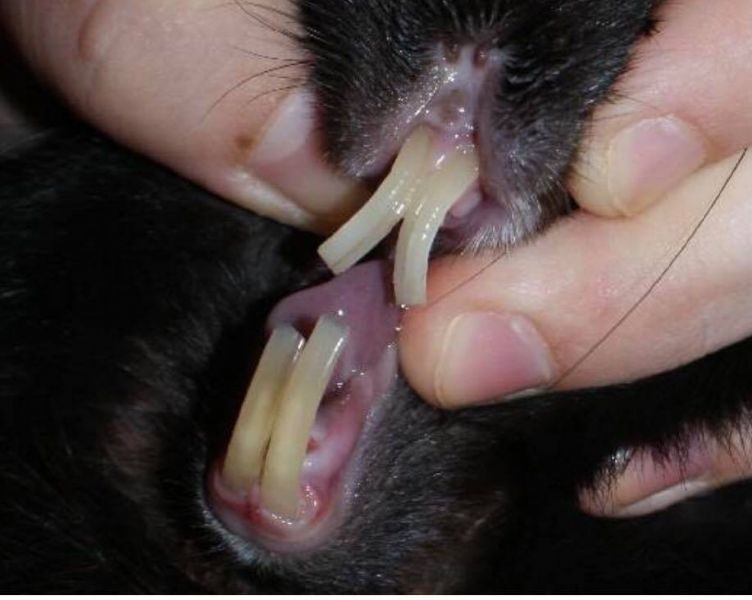
- Weight loss or emaciation due to reduced food intake.
- A wet chin, wet spots on the front paws, drooling under the mouth, at the corners of the mouth, or on the neck.
- Diarrhea or other digestive issues (not necessarily persistent), often resulting in irregular or mushy poops.
- Teeth grinding.
- Overgrown, broken, or misaligned front teeth upon inspection.
- Reduced production of poops or the appearance of „stringy“ poops connected by fibers (not fur, as during shedding).
- Digestive problems (bloating, constipation, stomach dilation, diarrhea, refusal to eat…).
- The rabbit keeps its mouth slightly open and doesn’t close it fully.
- Gradually avoids certain foods (e.g., items that need to be bitten off or harder foods) and often only eats shredded or soft food.
- The rabbit appears to eat but struggles to properly grasp or chew the food, or the food falls out of its mouth.
- It takes longer to eat, is constantly hungry, rummages through, and searches for food.
- Excessive chewing or chewing on one side of the mouth.
- Increased fluid intake or excessive drinking.





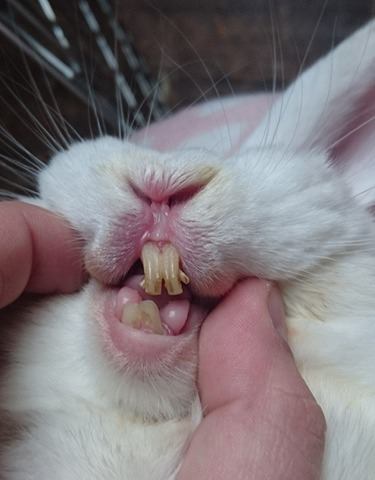

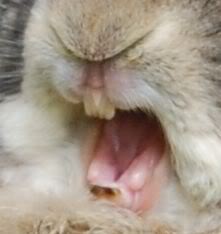





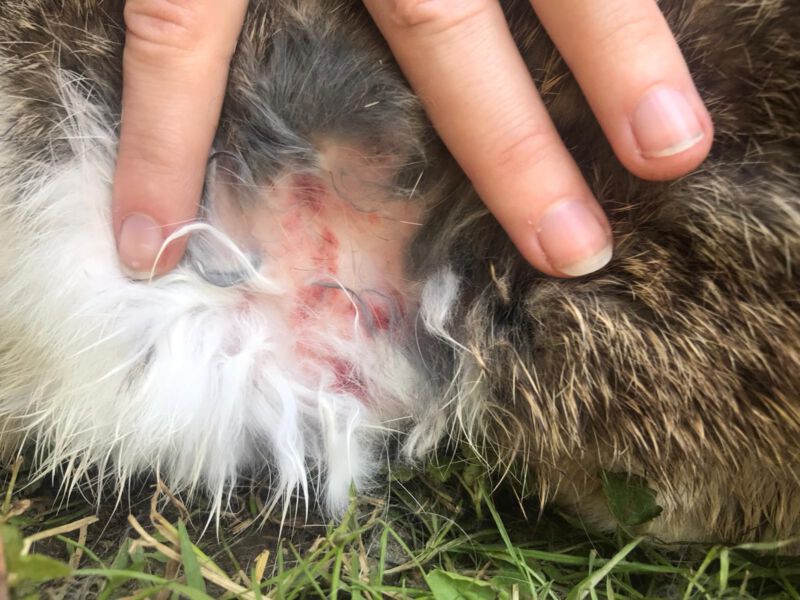








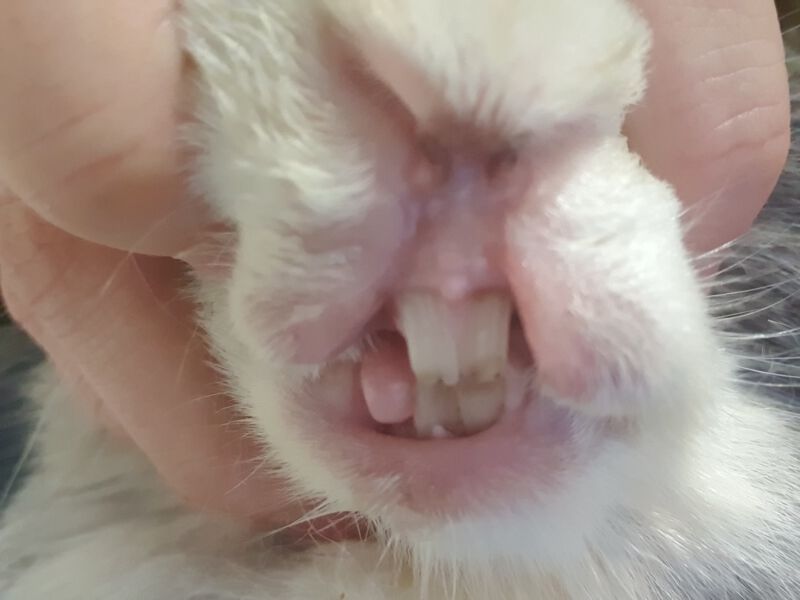










The peg teeth can be examined from the side during a health check. The three images on the left show an unhealthy set of teeth with overgrown peg teeth. It’s important to check not only the length but also the shape of the surface. This surface should extend the cutting edge of the incisors, running horizontally or slightly sloping toward the molars, but it should not form a triangular shape (as seen in image 3). The image on the right shows a healthy set of teeth, where the peg teeth fit snugly against the cutting surface of the incisors. Additionally, the length of the incisors should be assessed, ensuring the upper and lower incisors are approximately the same length.

There are also indirect symptoms that are often not immediately linked to dental diseases and, as a result, frequently go unnoticed or are only recognized after multiple veterinary visits and proper diagnostics:

- The nasolacrimal duct runs very close to the roots of the teeth, so issues with the upper jaw (retrograde tooth growth, jaw abscesses, etc.) often become visible only through nasal or eye discharge.
- Unilateral or bilateral eye discharge (the tooth roots, due to the pressure of overgrown teeth, push into the nasolacrimal duct; see diagram on the right).
- Protrusion of one eye.
- „Snuffles“ or nasal discharge.
- Lumps detected when palpating the lower or upper jawbone.
- The rabbit becomes withdrawn and less active.
Causes: How Do Dental Diseases Develop?
The main causes of dental problems are:


Rabbits do not have tooth roots because new material is constantly formed at the bottom of their ever-growing teeth, and the specialized tooth-supporting apparatus pushes them upwards, causing them to grow. This delicate tooth-supporting system, with its periodontal ligaments, can be damaged by improper food, preventing the teeth from being pushed upwards. As a result, the tooth „grows“ into the bone and often into the eye socket, the tear duct, or it may break through the lower jaw outward.
- Insufficient tooth wear (due to the continuously growing teeth) caused by an improper diet: Feeding dry food, bread, too much corn, or grains is the primary cause of dental issues. Rabbits need high-quality hay and a variety of green foods like grass, dandelion, clover, leafy twigs, vegetable greens, leafy vegetables, and herbs for proper tooth wear around the clock. Commercial rabbit food and bread are completely unsuitable for their diet, and other energy-rich foods should only be given sparingly and when necessary. The more rabbits chew, the better their tooth wear. They chew most effectively when provided with fibrous (not ground or crushed) foods that are not too energy-dense, taste good, and are available at all times.
- Food that is too hard (such as dry food, hard bread, or primarily feeding solid vegetables and fruits instead of soft, easy to chew foods like leafy greens or herbs): Rabbits chew these foods similarly to humans, breaking them down rather than grinding them, as they would with green food. This puts excessive pressure on the sensitive tooth sockets, leading to long-term retrograde growth or inflammation.

- Congenital Jaw Misalignments or Genetic Tooth Malformations: These are often observed in rabbits bred without genetic knowledge, particularly in dwarf rabbits (e.g., brachygnathia superior in short-headed rabbits) or in rabbits with congenital genetic predispositions, such as Satin rabbits.
- Raising on Pellets/Dry Food and Hay: This practice is common in many pet store breeding operations. During this phase, the shape of the head and jaw muscles can be altered by an unnatural diet, which can later lead to dental problems.
- Traumatic Tooth Disorders: These occur due to physical trauma, such as the use of mouth spreaders, biting on cage wires, or impacts to the front teeth when rabbits panic and run into walls or objects, or from falls that result in landing on the front teeth. It can also happen when teeth are clipped using pliers („nipping“).
- Age-Related Dental Diseases: These occur due to natural shifts in the teeth as the rabbit ages.
- Tooth Problems Caused by Osteoporosis, Mineral Deficiencies, or Disruptions in Calcium-Phosphorus Metabolism: For example, this can be caused by a calcium-deficient diet, vitamin D deficiency, medications, neutering, or food refusal/poor nutrient absorption due to other illnesses. Keep in mind that vitamin D is particularly important for indoor rabbits! A deficiency in this „sun vitamin“ is a major cause of dental misalignments in rabbits kept indoors.
- Reduced Food Intake Due to Other Illnesses: When rabbits refuse food, they chew less, which results in insufficient tooth wear and can lead to dental diseases.
- Changed Chewing Behavior Due to Ear Infections: This is often seen in rabbits, such as some dwarf breeds, with undiagnosed ear infections.
- Hand-Raising of Rabbits: This can result in mineral deficiencies during the growth phase, which may lead to dental problems.
Even if an animal doesn’t need to chew much because it is fed food that is richer in energy than greens, the teeth will still grow.
When guinea pigs and rabbits are given food that fills them up faster than the food nature intended, they chew less, and their teeth become too long. A common but incorrect belief is that animals should be given something „hard,“ like dry bread, to promote tooth wear. This is not correct, as the only thing hard enough to wear down a tooth is another tooth. This wear, tooth against tooth, happens during normal chewing.
The dental structure of rabbits and guinea pigs is one of the most specialized in the animal kingdom. The shape of their teeth and the structure of the tooth and its root are highly specialized for grinding soft, fresh, leafy food. If these animals are given food that doesn’t match their highly specialized teeth and cannot be ground down with their natural chewing movements, the teeth and tooth roots are stressed incorrectly, which can lead to serious dental problems. Therefore, improper feeding is the main cause of most dental issues in rabbits and guinea pigs.
„Misalignments“ are almost never congenital but are caused by insufficient tooth wear or improper stress.
Dr. med. vet. Diana Ruf, http://tieraerztin-ruf.de/2017/07/24/gesunde-ernaehrung-von-meerschweinchen-und-kaninchen/

Although the generally ‚harder‘ food is one of the main reasons domestic rabbits often suffer from dental issues, while their wild relatives usually remain unaffected, the exact relationship is not yet fully understood. The current study, however, offers new and important insights. It shows that the actual dentition (the molar unit) is essentially the same in both domestic and wild rabbits. However, the overall skull morphology differs significantly: the heads of domestic rabbits are higher and shorter, while wild rabbits have much flatter and longer skulls. This has corresponding effects on the chewing muscles. In domestic rabbits, the muscles are steeper and generate higher chewing pressure, especially in the back molar region. In contrast, wild rabbits can distribute the force more evenly across their molars (due to the flatter muscle structure).
But why is the head of domestic rabbits shorter? Various studies have demonstrated that the type of food heavily influences the development of the jawbone. This so-called phenotypic plasticity is particularly evident in young rabbits (after they are weaned). […] This connection is especially pronounced in young animals. Subadult rabbits that ate mostly coarser food (such as hay and pellets) developed larger jawbones and stronger chewing muscles in a relatively short time. Combined with unnatural chewing motions, this increases the pressure on the molars and can lead to pathological changes in the tooth roots (retrograde root elongation). Additionally, very coarse, fibrous hay provides relatively little energy, so the rabbits need to eat large amounts throughout the day to feel full. This further increases the stress on their teeth and raises the risk of gum inflammation from ingrown stalks.
Consequences Simply feeding hay with a higher flower content or offering dried herbs is not a good alternative. Such ‚crumbly‘ food quickly breaks apart in the mouth, leading to insufficient tooth wear. Rabbits need fresh food: soft food that can be ‚cut‘ by their teeth in a species-appropriate way, placing lateral pressure on the teeth, rather than axial pressure. In summer, this would be fresh ‚meadow food,‘ and in winter, leafy vegetables. High-quality hay must always be available, but it should not make up the majority of their diet.“**
Fr. Dr. Böhmer: „Unique Specialization of the Rabbit’s Dentition: Are There Differences Between Wild and Domestic Rabbits?“ Rodentia Nager & Co.

Examination & Diagnosis
Veterinarians are typically not trained to treat dental diseases in rabbits; a specialized veterinary dentist is required for proper care.

Finding a Rabbit-Savvy Veterinarian
A skilled veterinarian can usually inspect the rabbit’s incisors fairly easily (checking for color, structure, shape, length, etc.). If the incisors are too long or growing incorrectly, the molars are almost always affected as well.
However, the molars are much more difficult to examine. For an initial assessment, it is sufficient to use an otoscope or a cheek retractor to examine the mouth. A mouth spreader should never be used, as it can cause the jaw to fracture or the teeth to loosen, potentially leading to misalignment, abscessed tooth roots (and jaw abscesses), or broken teeth. This can result in significant pain and distress for the rabbit, potentially causing it to injure its hind legs or spine during defensive movements.
Caution: Please do not give pea flakes, nuts, parsnips, or any other white food before the appointment (e.g., to lure the rabbit into the box), as it could be mistaken for pus during the oral examination.

The video otoscope provides the best insight into the oral cavity of awake rabbits (photos: kaninchenseele.de). An examination can also be done with an otoscope or cheek retractor and a headlamp. The mouth spreader is attached to the front teeth and should only be used under sedation or anesthesia due to the risk of injury (photo: S. Wagner).
If dental disease is suspected, it is crucial to take X-rays of the teeth, as 80% of dental problems are located in the tooth sockets or roots, making them invisible from the outside! The head is X-rayed from various angles (planes) to better identify different conditions. For instance, a lateral view is required to assess whether the chewing surface and tooth roots are properly shaped and sized, and a 45-degree angled view is necessary to examine the tooth roots individually. Accurate evaluation of the X-rays is possible with reference lines by Böhmer and Crossley. Typically, no sedatives or anesthesia are required for X-rays, but anesthesia can help position the rabbit more effectively. As a result, many veterinarians opt to take additional X-rays in various planes or use anesthesia for dental X-rays as well.
If the tear duct is involved, additional diagnostics may include flushing the tear duct (is it clear?), staining the eye (is there an infection of the cornea due to chronic inflammation?), and possibly performing a contrast X-ray of the tear duct (where is the narrowing?).
Other imaging methods (intraoral X-rays, CT, or MRI) may also be used for diagnosis and, depending on the condition, can be more informative, especially when it comes to the tear duct, tooth remnants, and similar issues.


Treatment of Dental Diseases
Depending on the condition, the following treatment methods are chosen:
Incisor Tooth Diseases
Changes or misalignments of the incisor teeth are almost always caused by molar diseases! The teeth must be X-rayed in multiple planes by a dental specialist for rabbits and examined under anesthesia in the mouth, with appropriate treatment if necessary. Simply shortening the incisors without thoroughly examining/treating the molars does not solve the problem!

- Trimming Overgrown Incisors
Overgrown incisors should be trimmed according to reference lines, but the teeth should never be clipped with pliers. They must always be trimmed using rotating tools. This can sometimes be done without anesthesia. Clipping causes hairline fractures, loose or wobbly teeth, or porous tooth growth, which increases the risk of abscesses and infections! These trims need to be repeated every 3-6 weeks, which is why the removal of the incisors is often performed. Often, a correction of the molars is also necessary to ensure they are properly aligned and wear down naturally.
- Removal of Severely Misaligned Incisors
The removal of severely misaligned incisors is especially useful when only the incisors are affected and so misaligned that they can no longer be used for biting food. After the incisors are removed, rabbits can no longer bite food on their own and must be offered chopped or shredded food. This eliminates regular stress and veterinary visits.
- Broken Incisors
Broken incisors will regrow on their own, but the opposing tooth, which now grows unimpeded, needs to be trimmed or monitored to prevent misalignment. Additionally, the underlying cause of the broken tooth should be addressed. Brittle or decayed teeth often indicate root infections or disturbances in mineral metabolism. Kidney insufficiency or a vitamin D deficiency may also be possible causes.
- Incisor Misalignments in Young Rabbits
Incisor misalignments in young rabbits are rare and are not usually caused by molar diseases, but rather by a genetically shortened upper jaw. The earlier these teeth are filed, the more likely they can be corrected using filing techniques, much like with braces, where the teeth are gently pushed back into a normal position. Filing needs to be repeated several times, usually at intervals of 7-10 days.
- Surgical Removal of Teeth with Infected Roots
Teeth with infected roots (see abscessed jaw) must be surgically removed.
Molar Diseases

- Grinding of overly long molars according to the reference lines, removal of dental spurs, and similar issues. Only rotating instruments should be used for this procedure. Therefore, sedation is necessary. Snipping off larger pieces of teeth causes hairline fractures, loose or wobbly teeth, or porous tooth growth, all of which contribute to the formation of pus and jaw abscesses! After the treatment, a follow-up X-ray should be performed using reference lines to check if any further adjustments are needed, which can be done during the same anesthesia.
- Surgical removal of teeth with purulent „roots“ (see jaw abscess). The opposing teeth do not necessarily need to be removed: individual teeth wear down through contact with the neighboring teeth (rabbits grind their food). When many teeth are removed, rabbits typically chew on the opposite side, thus relieving pressure on the jaw. Also, the absence of the opposing tooth means there is no pressure on the remaining teeth. This lack of pressure often leads to a halt in further tooth growth, but additional adjustments may be needed (one to three times) until the growth completely stops. This should always be monitored! It is also possible to stop tooth growth surgically by destroying the growth area.
- Excessive grinding of teeth with retrograde growth can provide temporary relief and may help to stabilize the teeth, potentially halting further retrograde growth. Regular check-ups are necessary. If retrogradely grown teeth cause symptoms or have abscess capsules at the roots, they must be removed.
- Treatment of any oral mucosal injuries that may have occurred.

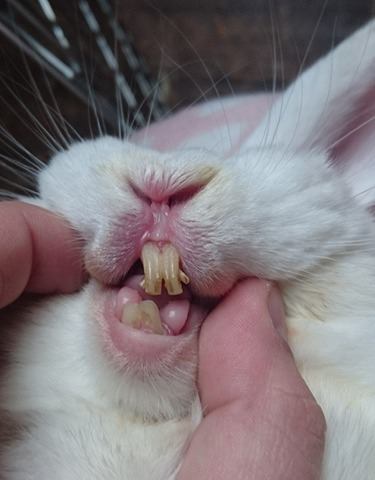
Correction without Anesthesia?
- About 80% of all dental diseases in rabbits are overlooked during an examination without anesthesia or sedation. Often, only the incisors are trimmed without addressing molar diseases. With anesthesia and X-ray diagnostics (in multiple planes), about 90% of dental diseases can be detected. Undiagnosed conditions often prevent the desired outcome from being achieved through treatment.
- An examination without anesthesia causes extreme stress in almost all rabbits, which can lead to shock and defensive movements (resulting in severe injuries to the spine, teeth, gums, or jaw, often causing malocclusions of the incisors).
- A mouth spreader must never be used without anesthesia, as it poses a risk of injury and damage to the teeth if the rabbit resists. However, it is indispensable for accurate diagnostics.
- „Mouth and cheek spreaders should not be used on conscious animals. They carry high injury risks, such as jaw fractures, jaw dislocations, gum injuries, and incisor fractures. Additionally, their use is painful for the patient both during the procedure and due to the significant pressure exerted on the jaw and teeth, which can cause pain for several days afterward.“ BVVD (2016): FAQ – Career Entry in Small Animal Practices, Enke Verlag.
- An examination without anesthesia leads to significant circulatory strain, which subsequently increases the risk during anesthesia.
- For professional dental correction, rotating tools are necessary, as only these allow for precise treatment and have the advantage over pliers that they do not loosen or splinter the teeth. Splintered teeth lead to inflammation, which often results in the complete removal of teeth or difficult-to-treat abscesses and pus formation. Rotating instruments should only be used on sedated rabbits for safety reasons (exception: incisors).
- With anesthesia, proper dental restoration is possible: grinding of the teeth according to reference lines, controlled by X-ray, addressing the root causes of the dental issue, and treating the entire problem (nothing is overlooked). This way, the animal will need far fewer treatments, and intervals between treatments may be significantly extended. Many rabbits, after years of clipping, may only need to have their teeth ground once and can continue wearing them down naturally for the rest of their lives.
Therefore, it is essential to examine and treat rabbits under anesthesia or sedation when dealing with dental issues. If there is a chronic dental problem that requires frequent trimming, it may be possible to try doing this without anesthesia, especially if the rabbit is older or not fit for anesthesia. However, a thorough dental restoration under anesthesia, along with X-rays from four different angles, should always be done first! Some rabbits may eventually get used to the stressful procedure. Nevertheless, the teeth should never be clipped with pliers but should be cut with a cutting disc, filed, or ground!

If the rabbit is not fit for anesthesia, corrections should be made as best as possible without it, or the rabbit should be stabilized enough to allow for sedation.
Each year, many rabbits die as a result of improper tooth clipping, especially when it’s more than just minor clipping (such as removing small tips). The consequences can be fatal. The hairline fractures (running lengthwise into the jaw) caused by clipping lead to infections, which can then result in pus and abscesses, leading to extremely high treatment costs. Often, these rabbits have to be euthanized.
Case example: Jaw abscess caused by „tooth clipping“ – Before and After


Gizmo’s molars became severely infected as a result of „tooth clipping,“ which led to a jaw abscess. Despite intensive treatment, he didn’t survive and had to be euthanized. Gizmo was put to sleep at the age of four. This fate is shared by countless rabbits in Germany.
My vet treats my rabbit’s teeth very carefully, and he does it all without anesthesia!“
Many pet owners fear anesthesia and thus opt for „tooth clipping“ using a mouth spreader. This is a dangerous approach: such treatment does not address the root cause or correct the reference lines but merely tinkers with the symptoms. As a result, the teeth often need to be clipped under pressure (using a mouth spreader) every 10 to 14 days, while the underlying condition continues to worsen and the animal suffers. By the time a qualified rabbit dentist examines the rabbit, the problem is often so advanced that it is difficult to treat. With early, proper diagnosis and treatment under anesthesia, the cause can often be identified and addressed, often eliminating the need for further treatment. The proper chewing surfaces are restored, enabling the rabbit to chew fresh food normally again. I frequently hear from owners who, after months or even years of having their rabbit’s teeth clipped, found that after a proper correction by a dental vet, no further treatment was needed. The underlying cause, which is usually responsible for the pain, is treated as well.
Most dental corrections, by the way, require only sedation (a strong tranquilizer), not full anesthesia, and the risks are minimal. Well-treated rabbits can often live to a very old age, even with regular sedation. In addition to the risk of spinal and leg fractures (due to defensive movements), clipping causes the teeth to splinter, creating fine cracks down to the roots, which leads to abscesses. Clipping a conscious rabbit’s teeth is an outdated practice. Would you also allow your own teeth to be pulled by the dentist as they did in the Middle Ages?

Case Reports
Moritz, a Satin Rabbit with Numerous Jaw Abscesses and Dental Problems
The entire lower right tooth row and one lower incisor were removed. Through surgeries and long-term antibiotics (Amoxicillin), the condition was brought under control, allowing him to live for several more years without abscesses.





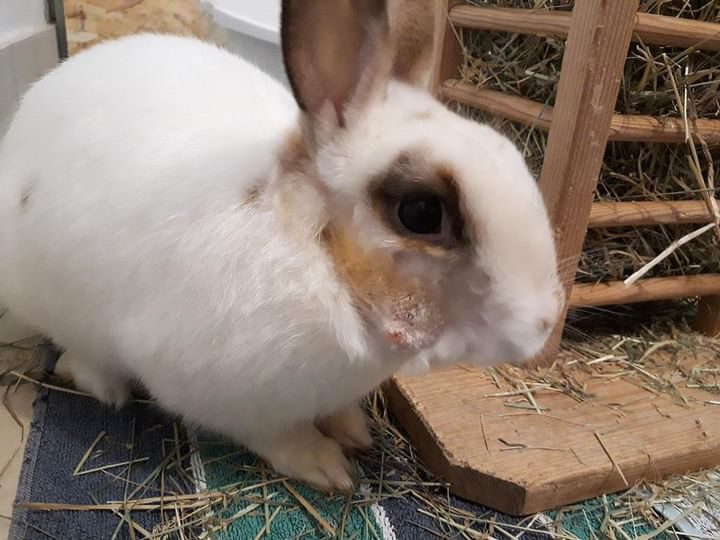
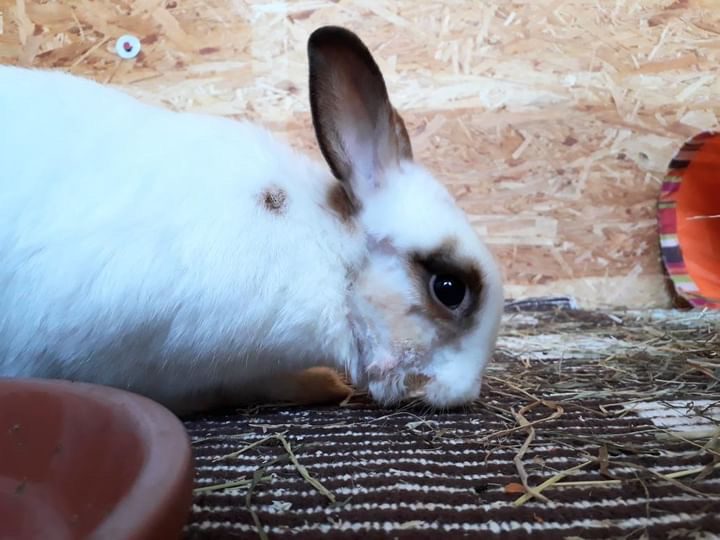

Mia
Mia had severe abscesses in two quadrants and overall very bad teeth. In several surgeries, all of her molars were removed (first the abscesses on the top right and bottom left, then gradually, depending on the severity). She still has all her incisors. One of her front teeth was affected at the root by the inflamed molars, but it grew back healthily after the diseased molars were removed. She now eats Cuni Complete from the automatic feeder (a handful twice daily) and vegetables (cucumber, cabbage, bell peppers… softer foods that she can bite into; no more grass). You wouldn’t even notice that she has no molars. Although I initially found the thought of a toothless rabbit strange, I would say I would do it again in a heartbeat. She got sick at 3 years old and is now 10 years old. After the dental treatment was completed, she hasn’t needed to see the vet for her teeth and has been completely healthy!




Nutrition for Dental Diseases
Nutritional imbalances are often the cause of dental diseases, so affected animals should be switched to a diet consisting solely of fresh leafy greens.
Improving tooth wear and potentially preventing the formation of tooth spurs, or extending the time between trims, can be read here: Tooth Wear.

Feeding After Dental Surgeries and for General Dental Diseases
However, if the incisors have been removed or if the animal has severe molar misalignments, a special diet is required.







Sources/Further Reading:
Böhmer, E., Crossley, D.(2009): Objective interpretation of dental disease in rabbits, guinea pigs and chinchillas. Use of anatomical reference lines. Schattauer
Böhmer, E. (2011). Zahnheilkunde bei Kaninchen und Nagern: Lehrbuch und Atlas; mit 27 Tabellen. Schattauer.
Böhmer, C., & Böhmer, E. (2017): Shape variation in the craniomandibular system and prevalence of dental problems in domestic rabbits: a case study in Evolutionary Veterinary Science. Veterinary sciences, 4(1), 5.
Böhmer, E. (2017): Frage an den Tierarzt/Tierärztin: „Sind die Zähne meines Kaninchens in Ordnung?“ [http://curoxray.de/blog/frage-an-den-tierarzttieraerztin-sind-die-zaehne-meines-kaninchens-in-ordnung/, 9.12.2017]
Ewringmann, A. (2016): Leitsymptome beim Kaninchen: diagnostischer Leitfaden und Therapie. Georg Thieme Verlag.
Ewringmann, A. (2017): Keimspektrum und Antibiotikasensitivitäten bei eitrigen Zahnerkrankungen von Kaninchen. Tierärztliche Praxis Ausgabe K: Kleintiere/Heimtiere, 45(06), 373-383.
Gabriel, S. (2013): Röntgendiagnostik bei Malokklusion des Kaninchens. veterinär spiegel, 23(01), 17-22.
Gabriel, S. (2014); Extraktion der Inzisivi bei Kaninchen. kleintier konkret, 17(S 01), 13-19.
Gabriel, S. (2016): Molarenextraktion bei Heimtieren–Indikation und Technik. kleintier konkret, 19(S 02), 18-22.
Gabriel, S. (2015): Praxisbuch Zahnmedizin beim Heimtier. Georg Thieme Verlag.
Glöckner, B. (2002): Untersuchungen zur Ätiologie und Behandlung von Zahn-und Kiefererkrankungen beim Heimtierkaninchen (Doctoral dissertation, Freie Universität Berlin, Universitätsbibliothek).
Glöckner, B. (2014): Spülung des Tränennasenkanals bei Dakryozystitis und Dakryostenose. kleintier konkret, 17(S 01), 27-30.
Glöckner, B. (2016): Dacryocystitis beim Kaninchen. team. konkret, 12(04), 8-13.
Gorrel, C. (2006). Zahnmedizin bei Klein-und Heimtieren. Elsevier, Urban&FischerVerlag.
Harcourt-Brown, F. M. (1996): Calcium deficiency, diet and dental disease in pet rabbits. The Veterinary Record, 139(23), 567-571.
Harcourt‐Brown, F. M., & Baker, S. J. (2001): Parathyroid hormone, haematological and biochemical parameters in relation to dental disease and husbandry in rabbits. Journal of Small Animal Practice, 42(3), 130-136.
Harcourt-Brown, F. (2006): Metabolic bone disease as a possible cause of dental disease in pet rabbits.
Harcourt-Brown, F. (2009): Dental disease in pet rabbits 1. Normal dentition, pathogenesis and aetiology. In Practice, 31(8), 370. [https://www.researchgate.net/profile/Frances_Harcourt-Brown/publication/298854593_Dental_disease_in_pet_rabbits_1_Normal_dentition_pathogenesis_and_aetiology/links/5794c62808ae33e89f97970b/Dental-disease-in-pet-rabbits-1-Normal-dentition-pathogenesis-and-aetiology.pdf, 9.12.2017]
Hartmann, M. (2007): Zahnextraktion hypsodonter Zähne bei Nagern und Hasenartigen. veterinär spiegel, 17(01), 22-27.
Jekl, V., & Redrobe, S. (2013): Rabbit dental disease and calcium metabolism–the science behind divided opinions. Journal of Small Animal Practice, 54(9), 481-490.
Korn, A. K. (2015): Zahn-und Kieferveränderungen beim Kaninchen: Diagnostik, Auftreten und Heritabilitäten.
Köstlinger, S. (2014): Vergleich der digitalen Röntgenuntersuchung mit der computertomographischen Untersuchung des Schädels bei zahnerkrankten Kaninchen(Doctoral dissertation, Bibliothek der Tierärztlichen Hochschule Hannover).




















